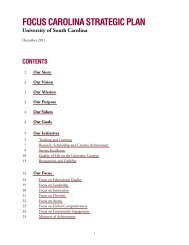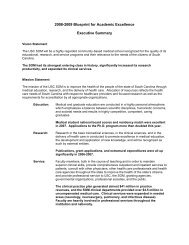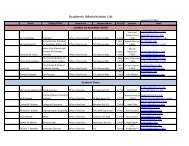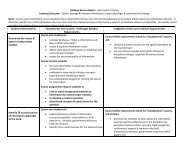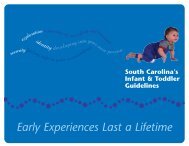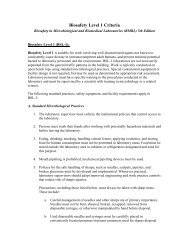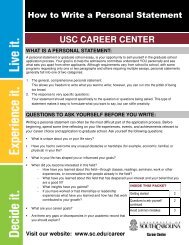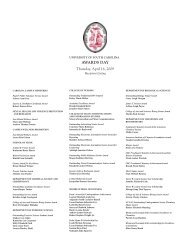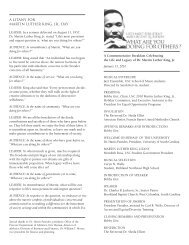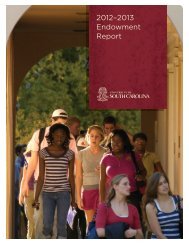APPENDIX to PLAYGROUND RATING SYSTEM
APPENDIX to PLAYGROUND RATING SYSTEM
APPENDIX to PLAYGROUND RATING SYSTEM
Create successful ePaper yourself
Turn your PDF publications into a flip-book with our unique Google optimized e-Paper software.
<strong>APPENDIX</strong> <strong>to</strong><br />
Play and Development<br />
Joe L. Frost<br />
Sue C. Wortham<br />
StuartReifel<br />
2001, Merrill Prentice Hall<br />
<strong>PLAYGROUND</strong><br />
<strong>RATING</strong> <strong>SYSTEM</strong><br />
© 1997 Joe L. Frost (revised)<br />
Used by permission of Joe L. Frost<br />
Rate each item for existence and function on a scale from 1 <strong>to</strong> 5<br />
0 = nonexistent<br />
1 = some elements exist but not functional<br />
2 = poor<br />
3 = average<br />
4 = good<br />
5 = all elements exist: excellent function<br />
Divide the final <strong>to</strong>tal score (out of a possible 300) by 3 <strong>to</strong> obtain<br />
final rating (out of a possible 100)<br />
Note: This rating scale is not intended as a research <strong>to</strong>ol but as an aid <strong>to</strong> planning<br />
and evaluating playgrounds.
Playground Rating System<br />
© 1997 Joe L. Frost (revised)<br />
Used by permission of Joe L. Frost<br />
Score<br />
Section I: What does the playground contain?<br />
1. A hard-surfaced area with space for games and a network of<br />
paths for wheeled <strong>to</strong>ys<br />
2. Sand and sand play equipment<br />
3. Water play areas with fountains, pools, and sprinklers, and water<br />
play equipment<br />
4. Dramatic play structures) playhouse, car or boat with<br />
complimentary equipment, such as adjacent sand and water, and<br />
housekeeping equipment<br />
5. A superstructure with room for many children at a time and with a<br />
variety of challenges and exercise options (entries, exits, and<br />
valleys)<br />
6. Mound(s) of earth for climbing and digging<br />
7. Trees and natural areas for shade, nature study, and play<br />
8. Continuous challenge, linkage of areas, functional physical<br />
boundaries, and vertical and horizontal treatment (hills and valleys)<br />
9. Construction area with junk materials such as tires, crates,<br />
planks, boards, bricks, and nails; <strong>to</strong>ols provided and demolition and<br />
construction allowed<br />
10. A purchased or built vehicle, airplane, boat, or car that has been<br />
made safe, but not stripped of its play value (should be changed or<br />
relocated after a period of time <strong>to</strong> renew interest)<br />
11. Equipment for active play (a variety of overhead apparatus,<br />
climbers, slides, balancing devices, swings, etc.)<br />
12. A large soft area (grass, bark, mulch, etc.) for organized games;<br />
a concrete or asphalt area for organized games<br />
13. Small semiprivate spaces at the child’s own scale (tunnels,<br />
niches, playhouses, hiding places)<br />
14. Fences, gates, walls, and windows that provide security for<br />
young children and are adaptable for learning/play<br />
15. A garden for flowers located so that they are protected from<br />
play, but with easy access for children <strong>to</strong> tend them; garden <strong>to</strong>ols<br />
16. Provisions for housing of pets; pets and supplies available<br />
17. A transitional space from outdoors <strong>to</strong> indoor. This could be a<br />
covered play area immediately adjoining the playroom, which will<br />
protect the children from the sun and rain and extend indoor<br />
activities <strong>to</strong> the outside<br />
18. S<strong>to</strong>rage for outdoor play equipment, <strong>to</strong>ols for construction and<br />
garden area, and maintenance <strong>to</strong>ols. S<strong>to</strong>rage can be separate:<br />
wheeled <strong>to</strong>ys s<strong>to</strong>red near the wheeled vehicle trace; sand<br />
equipment near the sand enclosure; <strong>to</strong>ols near the construction<br />
area. S<strong>to</strong>rage can be next <strong>to</strong> the building or fence. S<strong>to</strong>rage should
Score<br />
Score<br />
Section I. What does the playground contain? (continued)<br />
aid in children’s picking up and putting away equipment at the end of<br />
each play period<br />
19. Easy access from outdoor play areas <strong>to</strong> coats, <strong>to</strong>ilets, and<br />
drinking fountains; shaded areas, benches, tables, and support<br />
materials fro group activities (art, reading, etc.)<br />
20. Accessibility, materials, and equipment for children of all<br />
abilities/disabilities<br />
SUBTOTAL OUT OF 100 POINTS<br />
Section II. Is the playground in good repair and relatively safe?<br />
1. A protective fence (with lockable gates) next <strong>to</strong> hazardous areas<br />
(streets, deep ditches, water, etc.)<br />
2. Eight <strong>to</strong> 12 inches of noncompacted sand, wood mulch or<br />
equivalent manufactured surfacing under all climbing and moving<br />
equipment, extending through fall zones and secured by retaining<br />
wall as needed<br />
3. Size of equipment appropriate <strong>to</strong> age group served; climbing<br />
heights limited <strong>to</strong> 6 <strong>to</strong> 7 feet, or just above standing/reaching height<br />
of children<br />
4. Area free of litter (e.g., broken glass), electrical hazards, highvoltage<br />
power lines, and <strong>to</strong>xic hazards<br />
5. Moving parts free of defects (e.g., no pinch and crush points,<br />
bearings not excessively worn)<br />
6. Equipment free of sharp edges and broken, loose, and missing<br />
parts<br />
7. Swing seats constructed of soft or lightweight material (e.g.,<br />
rubber, plastic)<br />
8. All safety equipment in good repair (e.g., guardrails, padded<br />
areas, protective covers)<br />
9. No openings that can entrap a child’s head (approximately 3.5’<br />
by 9”). See CPSC/ ASTM for measurements and tests)<br />
10. Equipment structurally sound; no bending, warping, breaking,<br />
sinking, etc; heavy fixed and moving equipment secured in ground<br />
and concrete footings recessed underground at least 4 inches<br />
11. Adequate space between equipment—typically 6 <strong>to</strong> 9 feet,<br />
depending on type of equipment (see CPSC/ ASTM)<br />
12. No signs of underground rotting, rusting, or termites in support<br />
members (probe underground)<br />
13. No metal slides or decks exposed <strong>to</strong> sun; use plastic<br />
components or place in permanent shade<br />
14. Guardrail and protective barriers in place that meet CPSC/<br />
ASTM height and other requirements<br />
15. No loose ropes, suspended ropes, or cables in movement area<br />
16. All balance beams, cables and chains at low heights—<br />
prescribed by CPSC/ASTM<br />
17. Signs at entry alerting <strong>to</strong> appropriate ages of users, need for
Score<br />
adult supervision, and any hazards<br />
18. No protrusion or entanglement hazards<br />
19. No tripping hazards—exposed concrete footings<br />
20. No water hazards—access <strong>to</strong> pools, creeks. No traffic<br />
hazards—streets, parking lots, delivery areas<br />
SUBTOTAL OUT OF 100 POINTS<br />
Section III. What should the playground (and the Play leader) do?<br />
1.Encourage play:<br />
• Inviting, easy access<br />
• Open, flowing and relaxed space<br />
• Clear, movement from indoors <strong>to</strong> outdoors<br />
• Appropriate equipment for the age group(s)<br />
2.Stimulates the child’s senses:<br />
• Changes and contrasts in scale, light, texture and color<br />
• Flexible equipment<br />
• Diverse experiences<br />
3.Nurtures the child’s curiosity:<br />
• Equipment that the child can change<br />
• Materials for experiments and construction<br />
• Plants and animals<br />
4.Suppots the child’s social and physical needs:<br />
• Comfortable <strong>to</strong> the child<br />
• Scaled <strong>to</strong> the child<br />
• Physically challenging<br />
5.Allows interaction between the child and the resources:<br />
• Systematic s<strong>to</strong>rage that defines routine<br />
• Semienclosed spaces <strong>to</strong> read, work a puzzle, or be<br />
alone<br />
6.Allows interaction between children:<br />
• Variety of spaces<br />
• Adequate space <strong>to</strong> avoid conflicts<br />
• Equipment that invites socialization<br />
7.Allow interaction between the child and adults:<br />
• Organization of spaces <strong>to</strong> allow general supervision<br />
• Rest areas for adults and children<br />
8. Supports functional, exercise, gross mo<strong>to</strong>r, active play<br />
9. Supports constructive, building, creating play<br />
10. Supports dramatic, pretend, make-believe play<br />
11. Supports organized games and games with rules<br />
This is an overview of relevant safety items. For details, refer <strong>to</strong> the United<br />
States Consumer Product Safety Commission’s Public Playground Handbook for<br />
Safety and the American Society for Testing Material’s Standard Consumer<br />
Safety Performance Specification for Playground Equipment for Public Use
12. Supports special play form (e.g., chase games, rough-andtumble,<br />
sand and water play)<br />
13. Promotes solitary, private, meditative play<br />
14. Promotes group, cooperative, sharing play<br />
15. Involves children in care and maintenance of playground<br />
16. Involves adults in children’s play and work/play activities—art,<br />
music, science, etc.<br />
19. Adults are trained in play value, playground maintenance and<br />
safety, emergency procedures<br />
20. The play environment is constantly changing—growing in<br />
challenge and complexity. Good playgrounds are never finished<br />
SUBTOTAL OUT OF 100 POINTS<br />
GRAND TOTAL OUT OD 300 POINTS<br />
Grand Total divide by 3= SCORE






